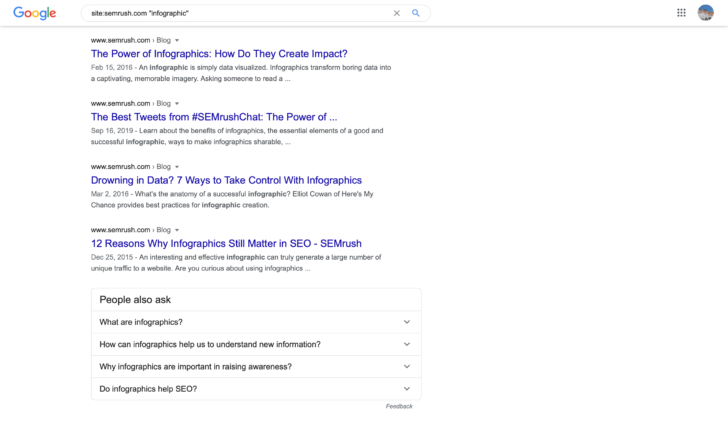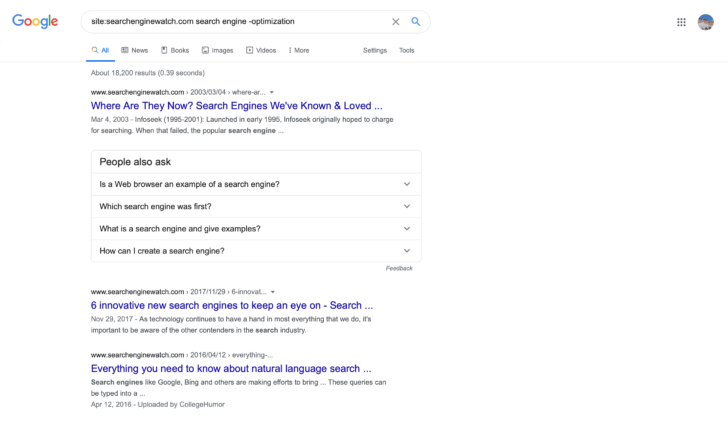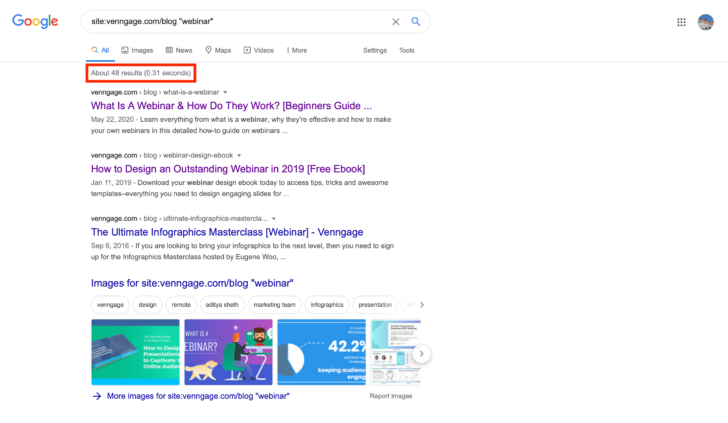Communication is integral to the proper functioning of any business – and what method of communicating is more fundamental than human speech?
Despite the rise of text and email in business communications, nothing really beats the ease of being able to simply dial up a colleague or client, make a personal connection, and talk things out.
Although video conferencing is gaining popularity, it's often viewed as more intrusive than phone calls. In fact, phone calls are still the go-to method:
A recent BrightLocal survey found that 60% of consumers prefer to contact businesses by phone.
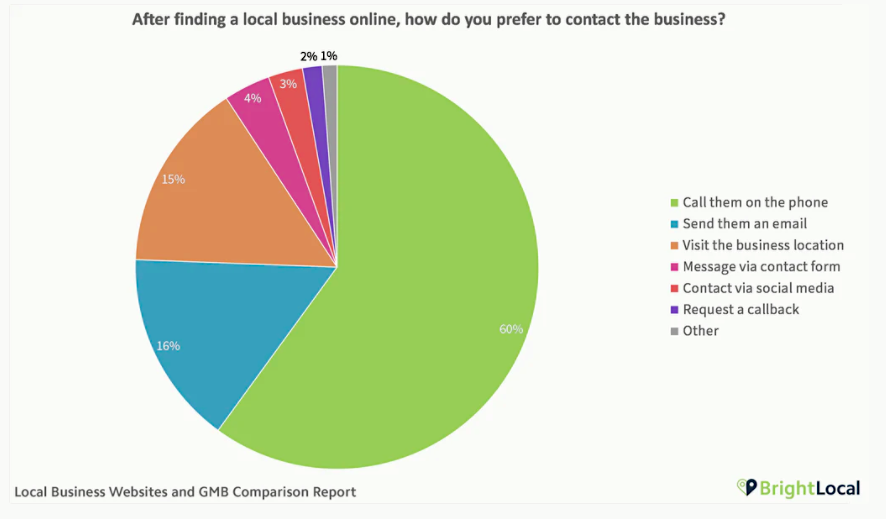
But even though the telephone is a staple of modern communication, it has by no means stayed the same over the past hundred years. Today, voice over internet protocol (VoIP) services offer a low-cost and high-tech alternative to traditional public switched telephone network (PTSN) solutions. In short, VoIP services push your voice through the internet instead of a traditional phone line.
In this guide, we’re going to go through eight of the best VoIP business phone services. We’ll let you know how much they cost, what features they come with, what makes them great, and what makes them not so great.
If you want to get straight to our top picks, scroll down to the section right below. But be sure to read the whole guide if you want to get an in-depth look at the top offerings in the space and some tips on how to choose the best business VoIP provider for your needs.
We’ve helped Fortune 500 companies, venture backed startups and companies like yours
grow revenues faster.
Get A Free Consultation
Best Overall Option: Nextiva
Nextiva is a giant in the VoIP industry, and if you’ve heard of it, you’re probably not surprised to see it making our top slot. Nextiva offers a high-end VoIP experience with a robust and reliable network, some great features, and a very affordable price to boot.
Nextiva was rated the number one business phone service provider in 2020 by US News and World Report, and 94% of Nextiva customers said they were satisfied with their experience. Customer satisfaction rates like that are almost unheard of!
When looking through Nextiva’s options, you get the feeling that the company has thought of everything. Plans come with desktop and conference room phones, making it one of the few VoIP services that include hardware.
Plus, Nextiva has a whole suite of video conferencing tools too, making it a fantastic all-around communication package.
Best Budget Option: Phone.com
If your priority is keeping costs low, Phone.com is worth your careful consideration. This company is able to keep its services affordable by offering flexible plans and, unlike the other services we looked at, they offer two types of plans: pay-per-minute plans and unlimited plans.
This allows businesses that don’t use their phones very often to save some money by shelling out for a pay-per-minute plan, while businesses whose employees have their elbows permanently bent in a ninety-degree angle can opt to pay more for unlimited minutes.
In short, Phone.com doesn’t force you to pay for more than you need. With plans starting at just $9.99/month, it’s one of the cheapest providers around. But of course, it still packs a punch with features like premium hold music and call analytics, depending on what plan you sign up for.
Best Freelancer and Solopreneur Option: Grasshopper
Not every business needs a desktop phone and dozens of extensions. Freelancers and solopreneurs sometimes need a business phone service just like any other company does, even if their needs are slightly different.
Grasshopper caters precisely to this demographic. Unlike many of the other services on this list, this company doesn’t focus on desktop phones. Instead, it provides a mobile app that makes it easier to run your business from your smartphone which, for many solopreneurs, also happens to be your personal phone.
For example, if you miss a call, you can have Grasshopper send an automatic text to follow up so that you don’t lose the client to someone else. Or, if you find yourself getting caught off guard picking up business calls when you’re in personal mode, you can ask Grasshopper to alert you when a call is business-related so you can move to a quiet area and prepare yourself to make a great impression.
Unfortunately, Grasshopper is a bit on the pricey side, especially considering that it doesn’t come with any hardware. Still, if you’re a solopreneur or freelancer, this is one business phone system that’s definitely worth looking into.
You may also like:
Business Phone Service Features Overview
Before we go any further, here’s a quick overview of some of the features of the services we’ll be reviewing:
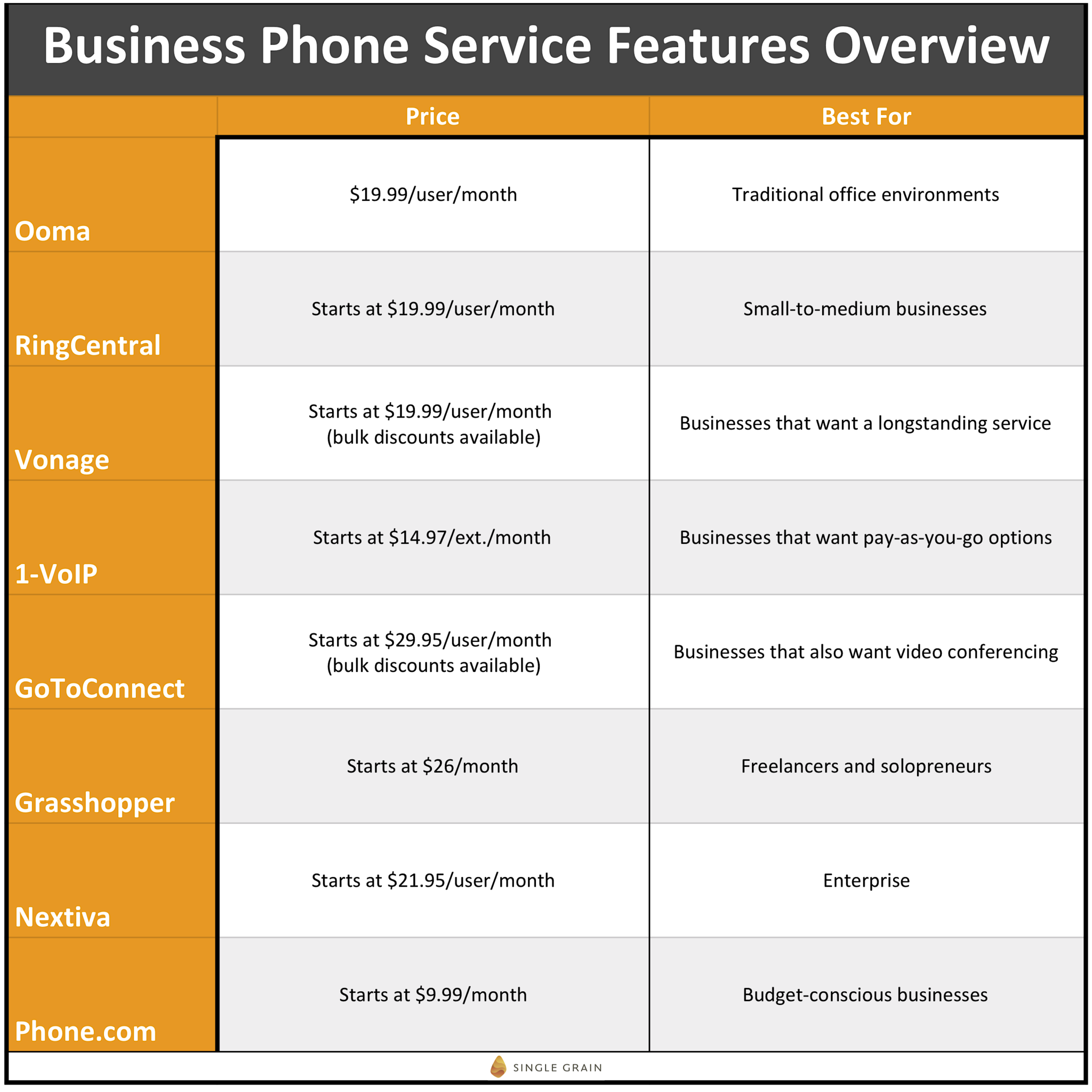
8 Best Business Phone Services
1) Ooma
Ooma Highlights:
* Website
* Pricing: Starts at $19.99/user/month
* Best for: Traditional office environments

Ooma is a well-established VoIP provider with a long track record of customer satisfaction. For the past seven years, PC Magazine voted Ooma the number one business VoIP, and that should be enough to make anyone give it some careful consideration when looking for the best phone service for their business.
Ooma markets its offerings as “big business features at small business pricing” — and they’re not lying. Ooma includes:
- Extension dialing
- Virtual receptionists
- Hold music
- The ability to keep your old number
- The ability to use the Ooma mobile to make and receive calls
For all this, Ooma charges $19.99/user/month. This fee stays the same no matter how many users you have, which keeps the pricing simple and free of unwelcome surprises as you grow your business.
All this sounds a bit too good to be true and, unfortunately, it is: Ooma doesn’t include the cost of hardware in its standard pricing. When you figure that in, Ooma doesn’t end up being as cheap as it seems. For example, its Business Phone Starter Pack costs $99.99 and comes with one Ooma base station and two wireless extensions, which are compatible with existing analog phones. Other packages that include actual phones are more in the $200 range.
That said, it is possible to use Ooma exclusively with the mobile app, which would eliminate the need for hardware. However, if that’s what you’re looking for, you may be able to find better and cheaper options for your needs.
Assuming you do go all in with Ooma, you’ll be happy to know that they provide superb customer service. Plus, they are known for having an easy set-up process, so between the ease of use and the helpline, you should be sailing smoothly after the initial financial investment.
2) RingCentral
RingCentral Highlights:
* Website
* Pricing: Starts at $19.99/user/month
* Best for: Small-to-medium businesses (SMBs)
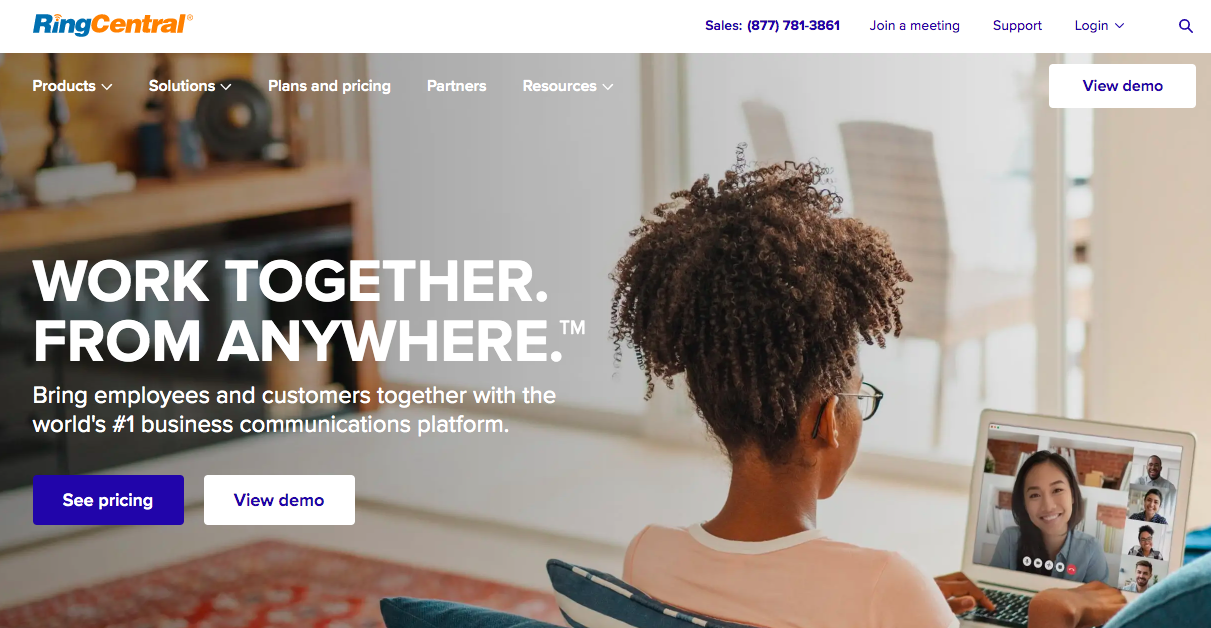
RingCentral is no small fry in the VoIP space. Touting over 2 million users, it’s clear that the company is doing something right.
While there’s a lot to like about RingCentral, one of its best points is that it has quite a few different plans available. Simply put, that means that users have options and won’t be pigeonholed into having to decide between plans that have either far too much or far too little. Plus, plans can be customized to include additional features like vanity numbers and international toll-free calling à la carte.
RingCentral offers four different plans, each building on the former:
Essentials:
- Starts at $19.99/user/month
- Maximum of 20 users
- Provides 100 toll-free minutes/month
- Unlimited domestic calls (U.S. and Canada)
Standard
- Starts at $24.99/user/month
- No users maximum
- Provides 1,000 toll-free minutes/month
- Unlimited audio and video meetings (maximum of 4 video participants)
- Unlimited internet fax
- On-demand call recording
Premium
- Starts at $34.99/user/month
- No user maximum
- Provides 2,500 toll-free minutes/month
- Video conference participant limit increased to 100
- Integrates with Salesforce and ZenDesk
- Automatic call recording
Ultimate
- Starts at $49.99/user/month
- No user maximum
- Provides 10,000 toll-free minutes/month
- Video conference participant limit increase to 200
- Automatic call recording
And no matter which plan you choose, you’ll have access to some features like:
- Unlimited SMS
- iOS and Android apps
- HD voice
- 24/7 customer support
- Call log reports
For most users, the deciding factors will be the number of toll-free minutes you get each month and how many people you can have on a video meeting at the same time. If you’re planning to use your VoIP very rarely, the Essentials plan should serve you well. But if you’re looking to use RingCentral for enterprise applications, you’ll need to go with one of the higher plans.
Overall, RingCentral provides a reliable VoIP service that can be tailored to each business’s needs.
We’ve helped Fortune 500 companies, venture backed startups and companies like yours
grow revenues faster.
Get A Free Consultation
3) Vonage
Vonage Highlights:
* Website
* Pricing: Starts at $19.99/month/line (bulk discounts available)
* Best for: Businesses that want a longstanding service
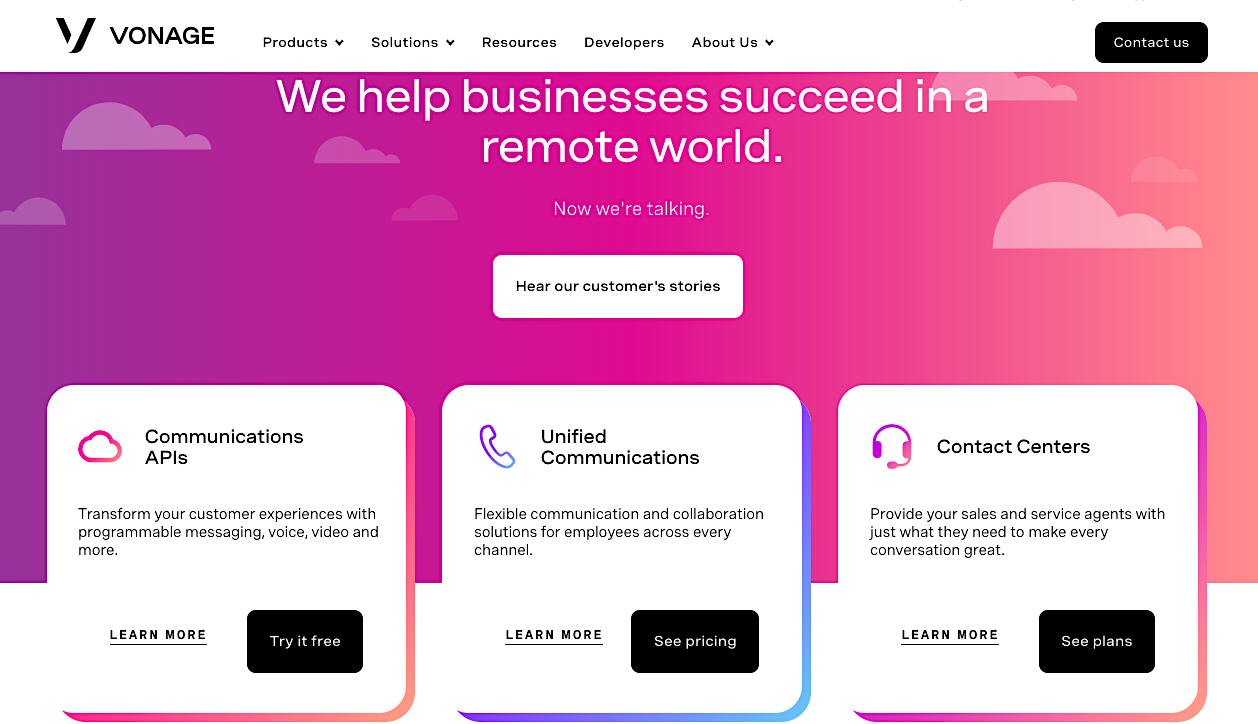
If you watched TV at all during the early 2000s, then Vonage may stir up some feelings of nostalgia for you. Back then, they were perhaps the best-known internet phone provider, thanks to its quirky commercials. But although the company was focused on residential VoIP in its heyday, they have since pivoted to concentrate on the more lucrative business phone market.
Vonage offers three different plans, each of which has different prices depending on the number of lines you choose:
Mobile
- Only allows calls to and from mobile devices and laptops or desktop computers
- Designed for remote teams and businesses that don’t require desk phones
- Pricing:
- 1-4 lines: $19.99/month/line
- 5-19 lines: $17.99/month/line
- 20+ lines: $14.99/month/line
Premium
- Allows calls from all types of devices, including traditional phones
- Designed for businesses with traditional office environments
- Pricing:
- 1-4 lines: $29.99/month/line
- 5-19 lines: $27.99/month/line
- 20+ lines: $24.99/month/line
Advanced
- Includes additional features like visual voicemail and call groups
- Provides a dedicated team for set up and onboarding
- Pricing:
- 1-4 lines: $39.99/month/line
- 5-19 lines: $37.99/month/line
- 20+ lines: $34.99/month/line
But Vonage’s plans are much more flexible than this list would have you believe. They offer a smorgasbord of add-on features to choose from, including visual voicemail, call recording and toll-free numbers.
Plus, they make it easy to purchase the hardware you need by providing you with a large selection of phones that have been tested for compatibility with Vonage. However, if you already have the hardware in place, they will work with you to make sure you can get your current setup working with their service.
You may also like:
4) 1-VoIP
1-VoIP Highlights:
* Website
* Pricing: Starts at $14.97/extension/month
* Best for: Businesses that want pay-as-you-go options

1-VoIP is the most flexible VoIP service on this list, and it’s pretty cheap to boot, with a starting price of $14.97/extension/month.
Unlike many of the other providers on this list, 1-VoIP offers a “pay as you go” or “metered” option for phone service. Instead of paying a flat monthly fee for more minutes, you can opt to pay $0.02/minute in addition to the base $14.97/extension/month price. This works out pretty well as long as you keep your usage to 200 minutes per month or less (after this point, you’d do better upgrading to a higher plan).
1-VoIP offers three different plans:
Metered:
- Starts at $14.97/extension/month
- Pay for what you use at a rate of $0.02/minute
Corporate
- Starts at $19.97/extension/month
- Better deal if you use more than 200 minutes per month
Professional
- Starts at $24.97/extension/month
- Includes hardware costs
No matter which you choose, every 1-VoIP plan comes with the same standard features. And that’s great considering there are over 40 of them. They include:
- Configurable caller ID
- Digital queues
- Custom hold music
- Voicemail
Unfortunately, 1-VoIP doesn’t have a mobile app, but you can use ZoiPer Softphone (a third-party app) to get all the same features (picking up and making calls, etc.) that you would have if 1-VoIP did have a mobile app.
Overall, 1-VoIP is a very good choice for businesses that need flexibility or aren’t sure how much they’ll be using their phone. According to its site, they have some of the highest customer ratings in the VoIP space, so if they’re to be believed, that’s a very good sign that you’ll likely have a good experience with their service.
5) GoToConnect (formerly Jive)
GoToConnect Highlights:
* Website
* Pricing: Starts at $29.95/user/month (bulk discounts available)
* Best for: Businesses that also want video conferencing
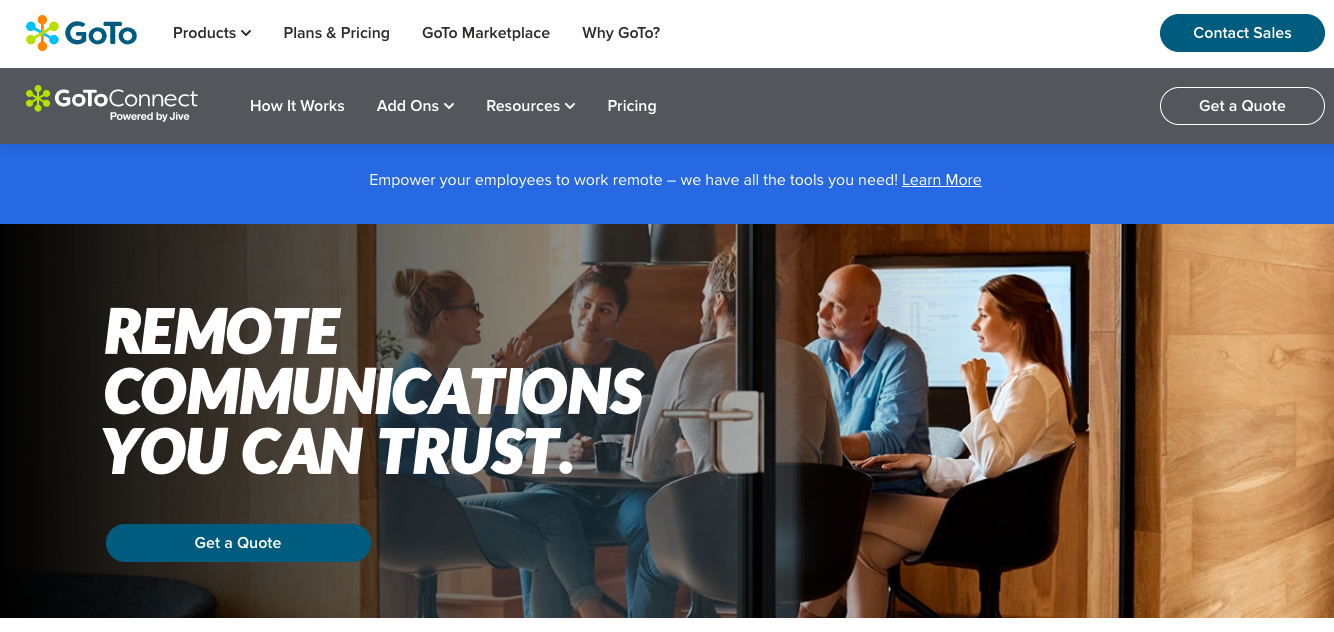
GoToConnect is a new offering that combines GoToMeeting’s audio and video conferencing capabilities with Jive’s VoIP phone service. The result is a one-stop communication package that provides everything most businesses will need to communicate effectively. It’s also entirely cloud-based, which may make it easier to maintain your hardware.
Overall, GoToConnect strives to be all-inclusive. Unlike other providers that price their services based on the features you select, GoToConnect bases its pricing entirely on how many users you’ll have. GoToConnect’s prices are:
- 1-4 users: $29.95/user/month
- 5-9 users: $25.95/user/month
- 10-24 users: $23.95/user/month
- 25-49 users: $21.95/user/month
- 50+ users: $19.95/user/month
As you can see, the more users you add, the less you'll pay.
And GoToConnect offers all the same features regardless of how many users you have. There are over 80 features, so there’s no doubt that this is one of the most complete packages on the market.
Some of GoToConnect’s features include:
- Call routing
- Caller ID
- Custom hold music
- International calling
- Wait time announcements
GoToConnect also stands out from the competition by offering features that are specifically designed for call centers, such as pre-call announcements, wait time announcements and unlimited call queues. It’s one of the only companies that seems to be making an active effort to appeal to the needs of call centers.
Overall, GoToConnect provides a high-end business phone experience. Compared to other services we’ve covered, it’s a bit on the pricey side, with a starting price that’s double 1-VoIP’s lowest-cost option, for example. That said, if you need a service that’s jam-packed with features, GoToConnect is definitely worth a look.
We’ve helped Fortune 500 companies, venture backed startups and companies like yours
grow revenues faster.
Get A Free Consultation
6) Grasshopper
Grasshopper Highlights:
* Website
* Pricing: Starts at $26/month
* Best for: Freelancers and solopreneuers
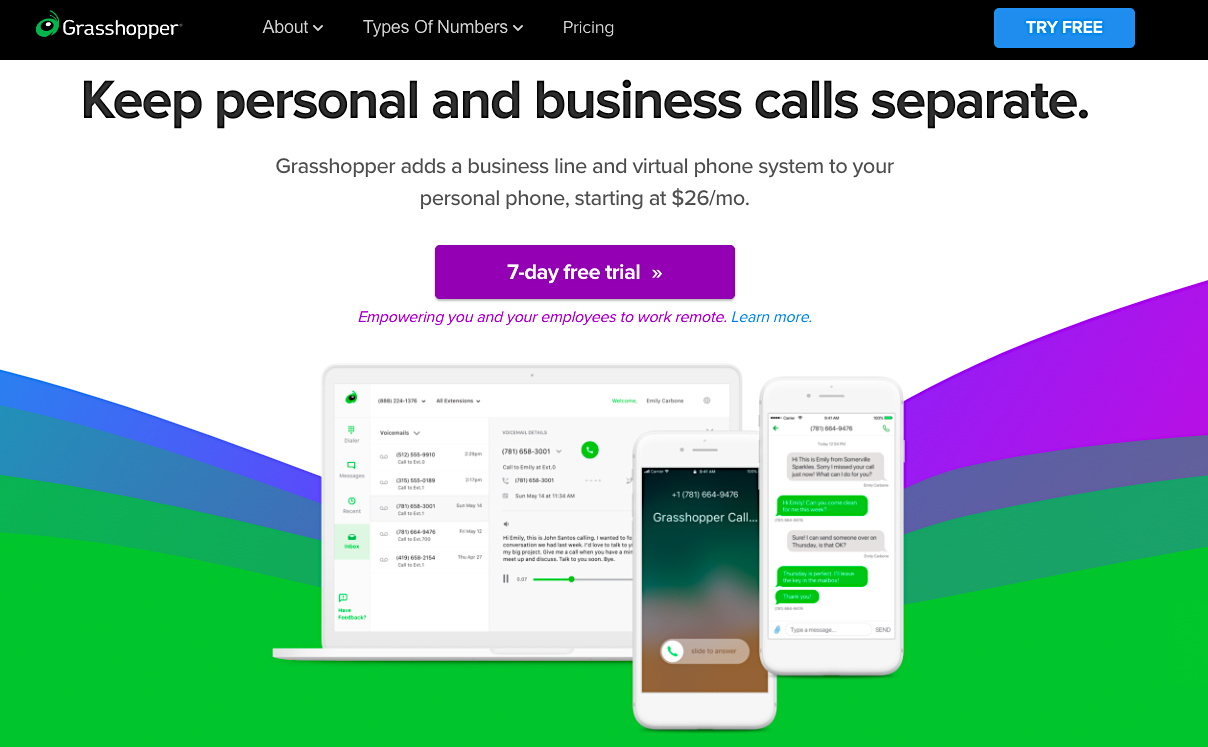
Unlike some of the other options on this list, Grasshopper is a pretty small company with a fairly modest offering. Whereas RingCentral has over 2 million users, Grasshopper has served just 350,000 “happy customers.” However, a small user base can sometimes be a plus: With fewer users, the company can dedicate more time and effort toward each individual.
Most of the options we’ve looked at so far are geared towards traditional office setups with desk phones. However, Grasshopper is a better fit for freelancers, solopreneurs and small teams who are planning to use their mobile devices to conduct business. Its main clientele is people who want a separation between their personal and business phones, but still want to use their mobile devices.
For example, real estate agents might want to give out their Grasshopper phone number to clients so that they can be easily reached without having to give out their personal number or carry around two phones all the time. It also alerts you when an incoming call is business-related so that you don’t get caught unprepared when you pick up the phone expecting a personal call and quickly realize that it's a potential client.
Grasshopper offers two services: Grasshopper and Grasshopper Connect. The main difference between the two is that Grasshopper Connect doesn’t just unify your business phone service; it also lets you view calls, texts and emails from one place.
Unfortunately, Grasshopper doesn’t come cheap. With a starting price of $26/month, it’s definitely a bit on the pricey side, especially considering that they don't offer any hardware. Grasshopper’s pricing is as follows:
- Solo: 1 number, 3 extensions, starting at $26/month
- Partner: 3 numbers, 6 extensions, starting at $44/month
- Small Business: 5 numbers, unlimited extensions, starting at $80/month
Keep in mind that with any plan you’ll be treated to some innovative features, like auto-texting, which can automatically send a text to any missed calls to try to prevent them from taking their business elsewhere. Overall, a great business phone system for solopreneurs, freelancers and small businesses.
7) Nextiva
Nextiva Highlights:
* Website
* Pricing: Starts at $21.95/user/month
* Best for: Enterprises
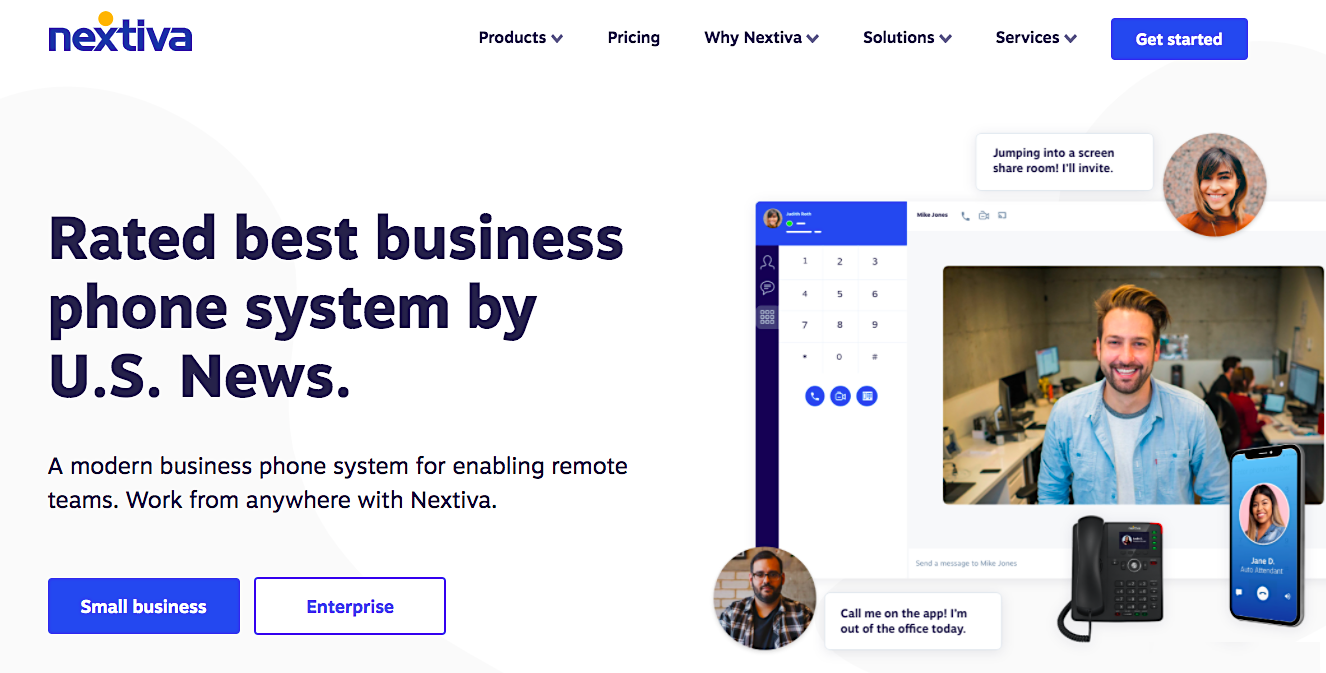
Out of all the providers we’ve looked at, Nextiva provides one of the most robust and reliable networks around and is a leader in the VoIP business phone space: They have connected over 1 billion calls, were rated the #1 business phone service in 2020 by US News and World Report, 94% of the businesses that have used Nextiva said they are satisfied with their service, and 90% of their customers say they’d recommend it to others.
So what makes Nextiva such a popular service? It offers enterprise business phone service at a very affordable price. Plus, it has great features, comes with the hardware you need, and has a very reliable network.
When you sign up with Nextiva, you’ll get:
- Desk phones
- Conference room phones
- Apps to manage your phone, text and email communications
- A mobile app
- Integrations with CRMs like Salesforce and HubSpot
Nextiva offers three plans, the price of which depends on the number of users and the features provided. Here are the plans and some of their features:
Essential:
- Starts at $21.95/user/month (discounts available for annual subscriptions)
- Unlimited calling within the U.S. and Canada
- 1,000 toll-free minutes
- Unlimited audio conferencing for up to 4 participants
- Google and Outlook integrations
Professional:
- Starts at $24.95/user/month (discounts available for annual subscriptions)
- Unlimited business SMS
- 2,500 toll-free minutes
- Unlimited audio conference calls for up to 40 participants
- Unlimited video conferencing
- Team messaging
- Call recording
Enterprise:
- Starts at $31.95/user/month (discounts available for annual subscriptions)
- 10,000 toll-free minutes
- Unlimited audio conference calls with unlimited participants
- Call recording
- Audio and video screen sharing
- Zendesk, HubSpot, Salesforce, and ServiceNow integrations
- Voicemail transcriptions
Each of these plans builds on the last, so if something is in the Essential plan, it will also be included in the Professional.
8) Phone.com
Phone.com Highlights:
* Website
* Pricing: Starts at $9.99/month
* Best for: Budget-conscious businesses
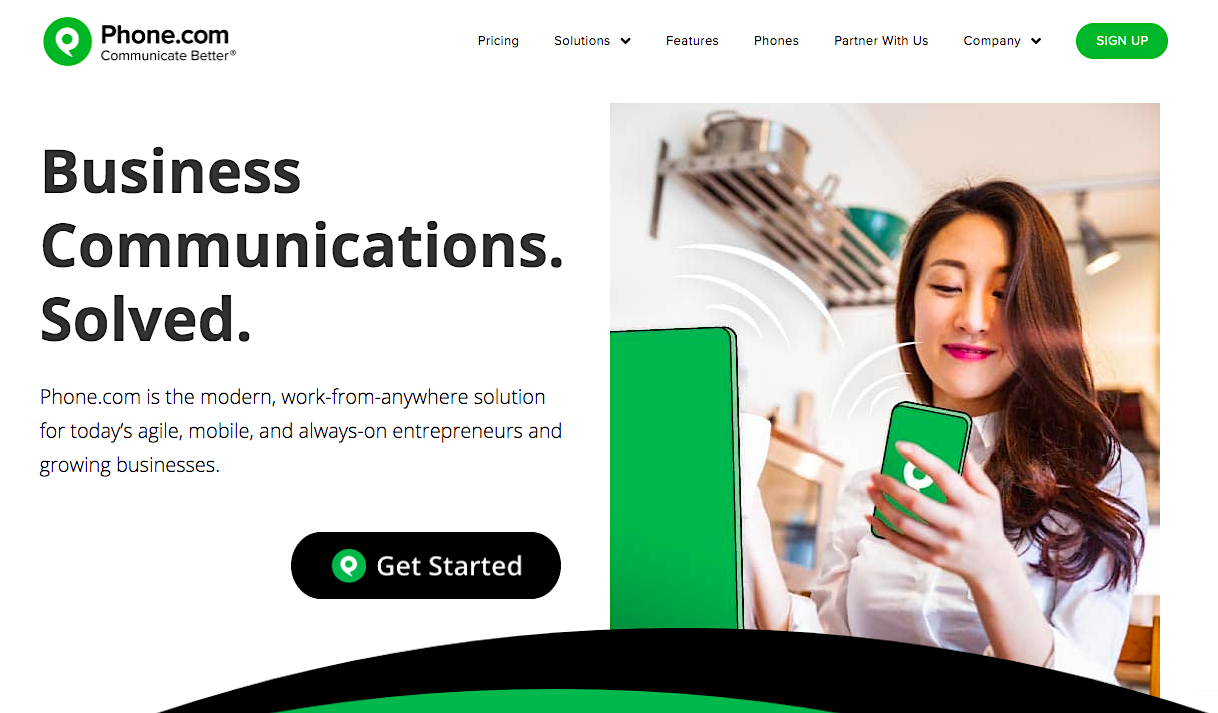
Phone.com differentiates itself in three ways:
- It’s cheap
- It’s HIPAA and HITECH compliant, so it’s a natural choice for medical professionals and businesses
- It’s the only service on this list that’s capable of dialing 911
With plans starting at just $9.99/month, Phone.com is the cheapest VoIP phone service you’ll find. It also provides a good deal of flexibility with its pay-per-minute options.
Phone.com divides its pricing into two subgroups: pay-per-minute plans and unlimited plans.
The pay-per-minute plans have the following prices and features:
Base:
- $12.99/month ($9.99/month if paid annually)
- 300 minutes/month
- 1 local or toll-free number
- 5,000 SMS messages
- Over 40 features, including call queuing and voicemail to email
Plus:
- $19.99/month ($14.99/month if paid annually)
- 500 minutes/month
- 2 local or toll-free numbers
- 10,000 SMS messages
- Additional features like premium hold music and automated voicemail-to-text
Pro:
- $39.99/month ($29.99/month if paid annually)
- 1,000 minutes/month
- 3 local or toll-free numbers
- 20,000 SMS messages
- Additional features like call analytics and 300 call recording minutes
The unlimited plans all have unlimited monthly minutes and unlimited user extensions:
Base:
- $29.99/extension/month ($24.99/extension/month if paid annually)
- 1 local or toll-free number
- 5,000 SMS messages
- Call forwarding
Plus:
- $37.99/extension/month ($32.99/extension/month if paid annually)
- 2 local or toll-free numbers
- 10,000 SMS messages
- Premium hold music
Pro:
- $59.99/extension/month ($49.99/extension/month)
- 3 local or toll-free numbers
- 20,000 SMS messages
- Call analytics
Despite their differences, all of these plans come with the same set of base features, such as:
- Fax-to-email
- Call routing
- Audio conferencing
- Voicemail-to-email
- Dial-by-name directory
- Auto attendant
As a whole, Phone.com is best viewed as a very good budget option. A good portion of the testimonials on its site mention that Phone.com is more reasonably priced than other comparable services and, luckily, they don't seem to sacrifice any quality to reach this low price point. Instead, it simply gives users a variety of options to choose from so that they won’t have to pay for more than they need.
We’ve helped Fortune 500 companies, venture backed startups and companies like yours
grow revenues faster.
Get A Free Consultation
You may also like:
How to Evaluate VoIP Business Phone Services on Your Own
In this guide, we’ve looked at eight of the best VoIP business phone services, but this list is by no means exhaustive. So if none of these options quite fits the bill, how do you go about evaluating other phone system offerings?
You can start by asking yourself these questions:
How large is my business?
Business phone systems often design their offerings with a certain type of business in mind, be it a solopreneur, small business or an enterprise. While many services offer different plans for different business sizes, some services are simply better equipped for one type.
When looking into VoIP providers, evaluate how their services might fit into your business. Does it provide enough extensions? Is the number of minutes sufficient for your needs?
How much phone time do you anticipate?
Business phone services tend to price their plans partially around the number of minutes provided. If you and your employees are constantly picking up the phone, then you’ll likely need a provider that offers unlimited plans. But if making calls is a rarity, you may want to go with a metered or pay-per-minute option.
What’s my budget?
It should come as no surprise that staying within budget is essential. Some providers are simply priced more competitively than others, so you’ll have to consider how that fits into the bigger picture. For example, can you afford more features? Or will you be better off with fewer features but a lower price tag?
What features are absolutely essential?
Every business has its own unique needs to consider. Some businesses will require phone services that have desktop phones, while others will fare just fine with a mobile app. Make a list of the reasons that you need a business phone service in the first place, and score each option on how well it meets those needs.
As with most decisions, there is no one-size-fits-all solution. Business phone services come in many different shapes and sizes, so you’ll need to find the one that fits best into your larger business strategy.
The post 8 Best Business Phone Services in 2020 appeared first on Single Grain.
from Single Grain https://ift.tt/31wYn4u




 Don’t scatter your images haphazardly. Think of the presentation of your blog post much like your living room. When you invite someone over, you clean it up and make it look neat, don’t you? (Your mom certainly hopes you do!) Keep your blog posts looking tidy by considering where and how you place your images.
Don’t scatter your images haphazardly. Think of the presentation of your blog post much like your living room. When you invite someone over, you clean it up and make it look neat, don’t you? (Your mom certainly hopes you do!) Keep your blog posts looking tidy by considering where and how you place your images.






 I, personally, prefer photographic images for blog posts, but icons and illustrations can complement your content just as well as photography. However, pick one category of imagery and keep it consistent per blog post. Don’t mix it up. Charts and graphs are images, too, and they may do a better job at conveying your message than a photo of a cup of coffee can. So, just stay consistent within a blog post but don’t limit yourself, either.
I, personally, prefer photographic images for blog posts, but icons and illustrations can complement your content just as well as photography. However, pick one category of imagery and keep it consistent per blog post. Don’t mix it up. Charts and graphs are images, too, and they may do a better job at conveying your message than a photo of a cup of coffee can. So, just stay consistent within a blog post but don’t limit yourself, either.

